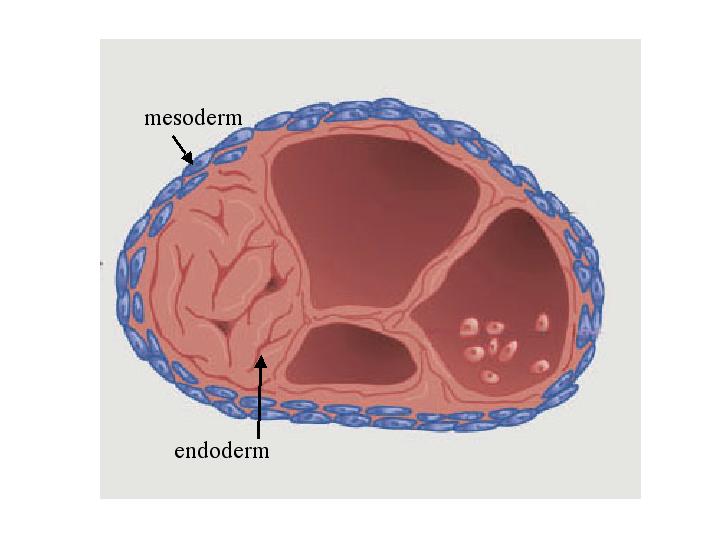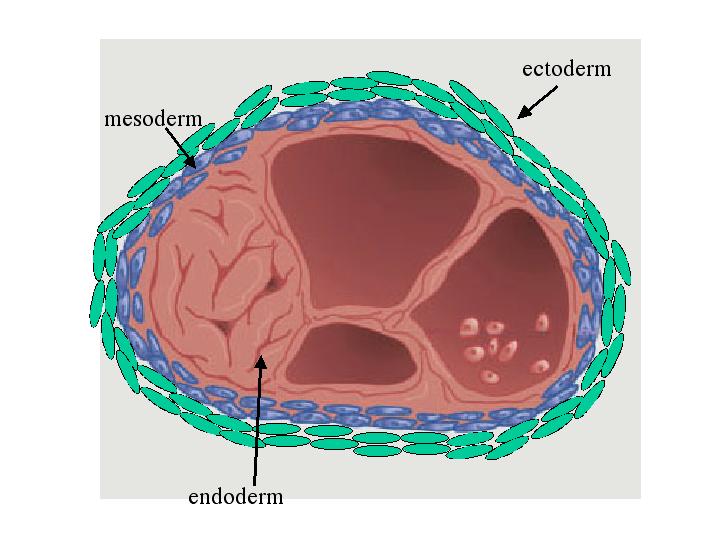

Homework 8 KEY
BIOL 114 section 2, Spring 2003
Due Friday 4/25/03 in class
10 points total.
1. a. Figure 19.15 (pg. 386) shows a diagram of a cell-sorting experiment carried out by Townes and Holtfreter. Sketch below a diagram predicting the results of a similar experiment in which you mix mesodermal and endodermal cells. Do the same for a mix of mesodermal, endodermal, and ectodermal cells. (2 points)
b. What
is the molecular mechanism that allows cells to sort in this way?
Relate cell sorting to differential gene expression in answering this question.
(2 points)
Different types of cell adhesions proteins (such as different types of cadherins) allow cells to adhere to one another in a specific fashion, with cells that contain a particular cell adhesion protein adhering to other cells with that same protein. Although all cells contain the same DNA, different cells contain different cell adhesion proteins due to differential gene expression.2. Predict the larval phenotype the following Drosophila eggs after fertilization with wild-type sperm. In ONE SENTENCE, explain why this phenotype is expected. (3 points)
a. Wild-type egg from which you remove anterior cytoplasm.This larva would have a bicoid-like phenotype, that is the anterior end would have tail structures instead of head structures. This would happen due to the loss of bicoid protein, which was located in the cytoplasm that was removed.
b. Wild-type egg to which you add (at its anterior end) anterior cytoplasm from a second wild-type egg.This larva would have anterior structures located more posteriorly than normal, because additional bicoid protein from the extra anterior cytoplasm would result in an altered gradient.
c. bicoid mutant egg to which you add (at its anterior end) anterior cytoplasm from a second wild-type egg.3. (3 points) Recent research has shown that the products of two different Drosophila genes are required to keep bicoid mRNA concentrated at the anterior end of the egg. In individuals with mutant forms of these proteins, bicoid mRNA diffuses farther toward the posterior pole than it normally does. Answer the following questions about these two new genes. Be sure to explain the rationale for your answer for full credit. (3 points)This larva would have a normal phenotype, because added cytoplasm would contain the bicoid protein which was originally lacking.
a. Predict what effect mutations in these two genes will have on segmentation of the larva.
Since bicoid mRNA diffuses towards the posterior pole in these mutants, the bicoid protein gradient would be disrupted. This would result in a larva composed entirely of thorax/abdomen structures, which are normallly located in the center of the animal where medium levels of bicoid are found.
b. Suggest a hypothesis for how these proteins function at the molecular level.These proteins (likely) function by binding to bicoid mRNA and to microtubules located in the anterior cortex of the egg.
c. Predict whether the mutations show a maternal effect pattern of inheritance.These mutations show a maternal effect pattern of inheritance. Bicoid mRNA is present in the egg ONLY at the anterior end, and this localization pattern is true BEFORE fertilization. Thus, these proteins must also be present in the egg, and thus must be transcribed and translated during egg formation (oogenesis).